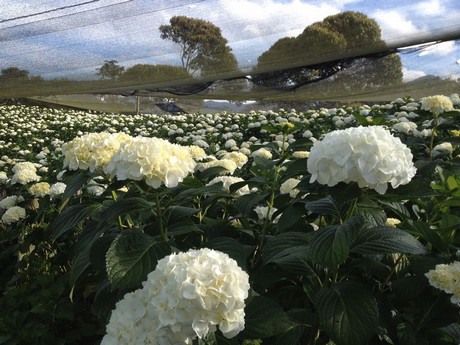
Hydrangea production
In the Antioqua region, many companies work with hydrangeas, but only a small part of them grows them. "The majority of the companies are traders and sell the products that are grown by several small growers. Most of them grow hydrangeas on 1ha or less. They find in this activity their livelihood", says Escobar.
Over the last years, the traders established the exportation channels and since then, the exports has grown significantly. "The department of Antioquia is currently exporting around 30% of the Colombian flowers. The United States is the main destination of its products, with about 78% of the total of exports, and therefore is an important ally for our traditional flower industry."
Exhaustive surveillance
However, as the numbers of Colombian hydrangeas entering the US has been soaring, an increase of flowers with pests was discovered by the North American Country Department of Agriculture. "As a result they turned on their alarms and started to cooperate with the Colombian Institution to minimize the risk that has been detected. This resulted in a more exhaustive surveillance over hydrangeas."
Impact environment and human health
Related to this subject is the use of agrochemical products and the impact on the environment and human health. In a meeting organized by the Secretary of Agriculture and Environment, a concern was raised that the increase in hydrangea cultivation also increased the indiscriminate use of agrochemical products. "This generates a need for education among the growers as the usage puts risk on human health, fauna and water sources that are not only used for the cultivation of flowers but for the population's consumption too. If this trend continues there will be a social issue here in Antioquia, contamination will increase and in fact we have seen in cities like Medellin that sometimes pollution levels are increasing until turning on red alert."
Over supply
On top of more exhaustive surveillance, pollution and the need for professional courses, growers are also dealing with over supply, once in a while. "As the number of hydrangea growers increased, the number of stems increased as well. So, in times when demand is low, there is an over supply and for many small producers they have two options; either throw them away or sell them under the cost price to recover some money since they live directly from the income of these sales."
Abandon activity
All in all, it affects the quality of life and wellness of the producers and, according to Escobar, some even abandon their activity. "If companies keep struggling with prices it is possible that some of them disappear leaving many people unemployed and the small producers around them without a source for their living. We are already seeing more and more growers in the area stop producing hydrangeas and move to the urban areas in search for new opportunities." Escobar regrets the situation as it also discourages the agricultural and rural development of Colombia.
What will be the advice?
According to Escobar, his advice mainly goes to the flower buyer worldwide. "It is important that these companies know what kind of companies they work with here in Colombia and see if they are taking care of the whole chain value. So, they should not only ensure they are offering good quality and affordable products but their work should also be socially and environmentally responsible."
He has advice to the trading companies in Colombia as well. "Over the last years, as the supply increased, they became very price oriented. Of course, when there is a big offer, prices go down and traders start paying less to growers, but I would suggest to focus less on price and more on sustainable development. And they should create awareness at their suppliers regarding the urgency of taking care of water sources and the importance for people to work with less or no pesticides."
For more inform
 ation:
ation:Flor Andina
Andres Escobar
Email: ciflorandinasa@hotmail.com
www.florandina.com
